Text
“…Another tricky thing about researching queer history is that our ideas about gender and sexuality have continually changed over the last 150 years, leading to a nearly endless string of forgotten terms such as tribade, urning, gynander, and invert. Other words have stayed in usage, but their meanings have radically changed, such as bisexual, which once meant roughly what we mean by transgender today. When you add in all the euphemisms, slang words, and legal categories, it becomes easy to miss (or misunderstand) queer history, even when it seems obvious.”
Ryan, Hugh, When Brooklyn Was Queer, (New York: St. Martin’s Press, 2019), 7.
3K notes
·
View notes
Text
“The term “bisexual” wasn’t in wide usage either as a concept of fluid sexuality (Lapovsky Kennedy and Davis, Boots of Leather, Slippers of Gold). The truth is, many women in the lesbian community of the 1940s and 50s also had relationships with men at some point in their lives, whether by desire, economic need, or other circumstances (Lapovsky Kennedy and Davis, Boots of Leather, Slippers of Gold). Some of these women were what we would today call lesbians, and some were bisexual. There is plenty of evidence for this in the historical research of Lapovsky Kennedy and Davis.”
—
”In an interview with iconic Black femme author Jewelle Gomez, Heather Findlay, mirroring Arlette’s confusion with double standards for studs and fems, says, “I know tons of butches who have slept with guys, and for some reason there’s not some big stigma attached to that. That doesn’t threaten their membership in the lesbian community, but with us it does” (150). These accounts of both studs/butches and fems having bisexual attractions and also being prominent members of the community indicates that bisexual women were, in fact, part of the lesbian community of the 1940s and 50s.”
The Evolution of Femme
613 notes
·
View notes
Link
March 12, 2013
—Leila J. Rupp
Interviews with queer women students at my campus make clear that these socially approved activities in the hookup culture also provide the opportunity to experiment with or act on already acknowledged same-sex desires. For example, one biracial and bisexual student I interviewed identifies as straight and never thought that she’d ever have a sexual experience with a woman. Then, she said, “[There were] a few times when I was intoxicated and I was at a party where…I just made out with one of my friends on the dance floor.”
She acknowledges she “may have fallen into that trap of, like, kissing a girl to impress a guy,” but mostly, she understood, it was more of just her own desire to experiment with a woman. Another student who identifies as lesbian/bisexual said it was “super easy” to hook up with boys, and then say, “‘Oh, I like girls.’” She also found participating in a threesome was a way to be with another woman, being that she was “too shy to try and hookup with girls all by themselves.”
Such comments remind me that heteronormative spaces have facilitated love and sexual activity between women in many different times and places. Take, for example, the existence of intimate sexual relationships between co-wives in polygynous households in China and the Middle East, prostitutes in brothels, and women in prison. Romantic friends in heterosexual marriages in the Euro-American world of the 18th and 19th centuries, and the “girlfriends” in avant garde cultural environments (such as Greenwich Village and 1920s Berlin) suggests that bisexual behavior between women, even without the concept of a bisexual or lesbian identity, flourished in a variety of societies. Compulsory heterosexuality and the expectation of marriage and child-rearing meant that women’s same-sex desires and sexual behavior often did not pose a threat to the gender order and sometimes even made for more harmonious heterosexual households by providing sexual pleasure for women.
2 notes
·
View notes
Link
Amanda E.K.June 19, 2019
In 1972, the National Bisexual Liberation Group was founded and issued the first bisexual newsletter, The Bisexual Expression. That same year, a Quaker group, the Committee of Friends on Bisexuality, issued the “Ithaca Statement on Bisexuality” supporting bisexuals. It was the first statement on bisexuality issued by an American religious assembly, and it appeared in the Quaker Friends Journal and The Advocate.
The 70s also saw the opening of the San Francisco Bisexual Center in 1975—the longest-surviving bisexual community center. It was this center that helped coordinate a response—with lesbian activists Del Martin and Phyllis Lyon, and pediatrician Dr. Benjamin Spock in 1977—when Anita Bryant launched a national anti-LGBTQ campaign in response to the first successful gay rights ordinance (co-authored by bisexual Alan Rockway).
In the 1980s, bisexual women began to organize spaces for themselves, such as the Boston Bisexual Women’s Network, which is still active today and publishes the quarterly newsletter Bi Women, the longest-running newseletter for bisexual women. That same year, BiPOL, the first bisexual political organization, was founded in San Francisco, which went on to sponsor the first Bisexual Rights Rally that took place outside the 1984 Democratic National Convention.
4 notes
·
View notes
Text
In general, I recommend the Internet Archive (archive.org) as you can digitally rent books from that site, and people have scanned dozens and dozens of books on queer history and African-American history. To rent books you just need to make an account, which is free. It’s a digital library. I also like to research bi women’s history, particularly femme bi women’s history, and here are some resources specifically on Black queer women (many of whom would be described as femme):
“““The Famous Lady Lovers:” African American Women and Same-Sex Desire from Reconstruction to World War II”, Christina Anne Woolner (2014)
“The oral history of Mabel Hampton, who socialized almost exclusively with queer women in 1920s and 30s New York, suggests that while various terms were used, many did not emerge until later decades. When Hampton was asked what she called lesbianism in the 1920s, she responded, “I didn’t call it anything but to say they liked women.” At the same time, in her recollections she referred to all-women parties where “the bulldykers would come and bring their women with them.” This suggests Hampton used the term “bulldyker” to refer specifically to masculine women, as was common at the time. However, vice reports from the 1920s also reveal feminine women who referred to themselves as “bulldaggers,” and performer Maud Russell claimed, “lesbians weren’t well accepted in show business, they were called bull dykers.” She recalled, “girls needed tenderness, so we had girl friendships, the famous lady lovers...I guess we were bisexual, is what you could call it today.” “Lady lovers” was also used in the black press interchangeably with “women lovers,” and as this term was indigenous to the urban North in the early-twentieth century, in black as well as white circles, I use it whenever possible. While many of the women in this dissertation had relationships with both men and women and were, as Russell noted, therefore “bisexual” in contemporary parlance, I rarely use this term since it was not utilized at the time. I refer to “lesbianism” throughout this study as the concept of women-loving-women and the act of building a life with a female partner while “lesbian” is generally referred to a trope in discourse.” (pp. 25-26)
https://deepblue.lib.umich.edu/bitstream/handle/2027.42/110469/cwoolner_1.pdf?sequence=1
-
Past Out: Who Were the Black Women-Loving Women of the Blues and Jazz Era?, Liz Highleyman (2003)
http://web.archive.org/web/20031229111512/http://www.womo.com/403/blues.htm
Odd Girls and Twilight Lovers: A History of Lesbian Life in Twentieth-Century America, Lillian Faderman (1991)
*a book on general queer women’s history in America, though it takes care to discuss the Harlem Renaissance and complex queer culture within the borough*
“The 1930s diary of Alice Dunbar-Nelson, a middle-class black woman [from Harlem], reveals the existence of an active black bisexual network among prominent “club women” who had husbands but managed to enjoy lesbian liaisons as well as a cameraderie [sic] with one another[.]”
https://archive.org/details/oddgirlstwilight00fade/page/98/mode/1up
A Study of a Public Lesbian Community, Ethel Sawyer (1965)
*likely the first known sociological study on Black American lesbian culture*
This is a good piece on stud/fish dynamics in the mid-1960s, & Sawyer, a straight woman, talks about bisexuality. Though she uses the stigmatized language of the time, she at least names and recognizes bisexuality amongst many of the fishes and some of the studs.
http://web.archive.org/web/20170814120144/http://elisechenier.com/wp-content/uploads/2016/02/Ethel-Sawyer-A-Study-of-a-Public-Lesbian-Community-1965.pdf
Angelina Weld Grimké (1880-1958), Brett Genny Beemyn (2015)
*a forgotten writer whose work includes poetry published during the Harlem Renaissance*
"[S]he never sought to publish many of her poems, apparently because they describe an attraction to women. Nor did she avoid the use of female pronouns[.] [...] Evidence suggests that Grimké was also attracted to men, but scholars have largely ignored this aspect of her life."
http://www.glbtqarchive.com/literature/grimke_aw_L.pdf
‘No Kisses Is Like Youres’: An Erotic Friendship between African-American Women During the Mid-Nineteenth Century, Karen V. Hansen (1995)
"Addie admitted to her attraction to men. However, her devotion to Rebecca created obstacles for those men[.]" (p. 194)
https://archive.org/details/lesbiansubjects00mart/page/178/mode/2up
Man Royals and Sodomites: Some Thoughts on the Invisibility of Afro-Caribbean Lesbians, Makeda Silvera (1992)
"[She] had lots of friends—both men and women." (p. 101)
https://archive.org/details/reclaimingsodom0000unse/page/94/mode/2up
“A house where queers go”: African-American Lesbian Nightlife in Detroit, 1940-1975, Rochella Thorpe (1996) → Inventing Lesbian Cultures in America
https://archive.org/details/inventinglesbian00lewi/page/n10/mode/1up
hey, quick question–does anyone know where I might be able to find more digital resources on Black queer femme (and/or stud + butch) history?
(I’m reading butch queens up in pumps by marlon bailey, but that’s pretty much the only relevant book written by a queer person that my local library had, and google refuses to find me sources that use all my keywords)
194 notes
·
View notes
Link
(Editor's Note: This 1971 pamphlet distributed by the CWLU [Chicago Women’s Liberation Union] explores the complex relationship between the gay and feminist movements. Anne Koedt was a pioneering NY feminist probably best known for her article, "The Myth of the Vaginal Orgasm".)
[...]
Acts of feminine transgression may take different forms. A woman may appear too self-reliant and assertive; she may work politically for women’s rights; she may be too smart for her colleagues; or she may have important close friends who are women. Often women have been called “lesbian” by complete strangers simply because they were sitting in a cafe obviously engrossed in their own conversation and not interested in the men around them. (Curiously enough it is precisely on the most seemingly “feminine” women that men will frequent this kind of abuse, since the purpose is more to scare the women back into “place” than to pinpoint any actual lesbianism).
[...]
Definitions
With the increased interaction between the gay and women’s liberation movements, a heightened consciousness about lesbianism has evolved among feminists—and along with it a corresponding disagreement and confusion as to what exactly it means to be a lesbian. It is clear that more is being implied than the straight dictionary definition of women sleeping with members of their own sex. Some women define it as meaning having sex exclusively with women, a more rigid definition than the one commonly used. Other gay women see lesbianism as much more than a defining term for the sex of your bed partner; to them it is a “total life commitment to a life with women” and “an entire system of world view and life living”. Indeed, some gay women seek to equate their lesbianism with vanguard radical feminism since “we rejected men and sex roles long before there even was a women’s liberation movement” For the purposes of this discussion the meaning of the word lesbianism is restricted to its simplest definition of “women having sexual relations with women” so that the various “life style” arguments which are sometimes added to the basic definition can be looked at separately.
[...]
Bisexuality
One position taken by some lesbians is that bisexuality is a cop-out. This is usually argued in terms like “until all heterosexuals go gay, we are going to remain homosexual,” or “lesbianism is more than having sex with women; it is a whole life style and commitment to women. Bisexuality is a sign of not being able to leave men and be free. We are women- (not men-) identified women.”
The first position mentioned is an apparently tactical argument (though it has also been used by some, I think, to dismiss the discussion of bisexuality altogether by safely pushing it off into the Millennium), and makes the case for politically Identifying yourself with the most discriminated against elements—even though you might really believe in bisexuality.
Taking that argument at face value (and I don’t completely), I think it Is a dangerous thing to advocate politically. For by, in effect, promoting exclusive homosexuality, they lend political support to the notion that it does matter what the sex of your partner may be. While I recognize the absolute necessity for the gay movement to concentrate on the freedom of people to sleep with members of their own sex (since it is here that discrimination exists), it must at the same time always be referred back to its larger, radical perspective: that it is oppressive for that very question even to be asked. As a matter of fact, if “freedom of sexual preference” is the demand the solution obviously must be a bisexuality where the question becomes irrelevant.
I think in fact that the reason why bisexuality has been considered such an unpopular word by most gays is nor to be found primarily in the arguments just discussed, but rather in gay adherence to a kind of fierce homosexual counter-definition which has developed. That is, a counter identity-- a “life style” and “world view”—has been created around the fact of their homosexuality. This identity is so strong sometimes that to even advocate or predict bisexuality is considered “genocide”’ The following is an example: In a response to a statement by Dotson Rader that, “as bisexuality is increasingly accepted as the norm, the position of the homosexual qua homosexual will fade," one gay response was that “The homosexual, like the Jew, is offered the choice between integration or the gas chamber.”3
[...]
3. Letter to the Editor. Evergreen, May 1971
-
0 notes
Quote
Another expression of female same-sex desire included what Vicinus calls, the “occasional lover of women.” These “free women” chose a highly varied sexuality, one that vacillated between women and men. Regularly, their appearance might signal an erotic interest in women, while at other times they might take on male lovers when playing the role of mistress, courtesan, or prostitute. However, they were also the first to be seen as a social problem by the vice and moral reformers, because of their gender deviance and their possible influence on male political leaders (Vicinus 1993, 438).
— Lesbian History
There’s a word for that. “Bisexual”.
(via our-lady-of-singularities)
https://outhistory.org/exhibits/show/lesbians-20th-century/beginnings
https://archive.org/details/lesbiangaystudie0000unse/page/436/mode/2up?q=%22occasional+lover%22
Martha Vicinus, “"They Wonder to Which Sex I belong": The Historical Roots of the Modern Lesbian Identity” in The Lesbian and Gay Studies Reader (pp. 437-438)
32 notes
·
View notes
Link
“It’s not often that lesbians and their straight sisters come together to talk about their sexuality. When 60 women met on November 11th at the Self-Help Clinic in Los Angeles, it was proof that a gay-straight dialogue can be a great learning experience for everyone.
The day began with speakers--gay, straight, bisexual, and asexual.
[...]
Anne, speaking as a bisexual, gave an hilarious talk on her development. She first married at 14. “I got pregnant and I was able to get an adult library card because I was married.” Anne used her card to take out books on sexuality. After her marriage ended, she went to San Francisco where she met “a woman who said fuck right out loud in public, and that was in 1959.” Anne remarked that when she found out this woman was a lesbian she was a little shocked, but couldn’t help thinking, “Here she was loving this woman and I was still having lousy sex with men.” She finally came out and has been with a woman for two years. Explaining her bisexuality, she said, “I believe you fall in love with the person and not the sex.”
[...]
Eve spoke on her reasons for her present asexuality. “Right now the feminist movement is taking all my energy. When I fond someone, woman or man, who is as warm and rel as I need them to be, then I might be willing to engage in a relationship with them.””
–JoAnne Mitchell, “An Advance of Sisterhood,” in The Lesbian Tide, Volume 2, Issue 5, December, 1972 (p. 11, p. 31)
2 notes
·
View notes
Text
The Lesbian Tide
Meanwhile, life on my own newspaper, the Lesbian Tide, was a study in lesbian contradiction and feminist paradox.
How did a raging butch get to be publisher of the nation’s premiere lesbian-feminist paper of the seventies? Like much of the turbulent seventies, it was a dialectic accident. I snuck in the back door.
In 1971, when DOB abbreviated my “communist” (Women against the War) presidency, they offered me the booby prize of remaining on the Board of Officers by holding the lowest position–newsletter editor. I accepted. I’d been editor of my high school paper; I knew the power of the press. From here, as Marx would say, it was just a hop, skip, and a jump as this editor collided with herstory. I changed the name of my four-page mimeograph from the DOB Newsletter to the Lesbian Tide, because I could feel the tide of herstory changing. The whole world was.
Realizing its mistake, the DOB membership soon voted me and my communist tide out of the organization. Politically, I’d been gone for months already. But I was now free to invite my lesbian-feminist soul mates onto the staff.
The mates of the not-so-collective Tide Collective reflected the infra-chaos of our movement. In addition to my paradoxical self, there was an archetypal lesbian-come-lately (from heterosexuality) feminist femme, co-editor Sharon McDonald; our very own politically correct Vassar white girl, Shirl Buss (who later processed her own organization, White Women against White Women against White Women against Racism, to death); an old-gay femme, Barbara Gehrke, a former navy woman who thought women’s liberation meant changing laws to make women free (poor dear!); and a bisexual, Cheri Lesh, who also must have crept in some window simply because she was a great writer. Lesh taught me that there were indeed a small percentage of human beings who did not find gender a factor in sexual attraction.
My ten-year indenture, 1970 to 1980, to the the Tide and this outrageous family of women helped me survive lesbian-feminism. With our Vassar analysis editor, Buss, I completed my studies in lesbian-feminist language: androgynous was a synonym for butch; cheating on your lover was called “having a nonmonogamous relationship”; and “role-playing” was “consciousness raising.” Learning all these new things was called “networking” or “skill building” depending on the environment you were studying. And, of course, fighting for your identity, even unsuccessfully, was called “processing.”
As the undercover butch publisher of the Lesbian Tide, I edited major features such as “Are Roles Really Dead?” and quoted myself as the anonymous “Mariane” (pretty femme, pretty clever)–defender of the now ancient heritage of butchdom. I survived through coups and controversy, not the least of which was whether the Lesbian Tide was a “lesbian-feminist” publication, or a “feminist lesbian” publication.
“Butches, lies, and feminism,” by Jeanne Cordova, in The Persistent Desire: A Femme-Butch Reader, ed. Joan Nestle, 1992.
69 notes
·
View notes
Text
The concept of bisexuality as it is currently used—to denote attraction to more than one gender—was still being established in the 1970s, although the term itself was first used in 1859 by the anatomist Robert Bentley Todd.[36] Todd used ‘bisexual’ to refer to the possession of ‘male’ and ‘female’ physical characteristics—what audiences today would understand as being intersex.[37]
[36, 37. Lachlan MacDowall, ‘Historicising Contemporary Bisexuality’, Journal of Bisexuality, 9 (2009), 9.]
–Martha Robinson Rhodes, “Bisexuality, Multiple-Gender Attraction, and Gay Liberation Politics in the 1970s,” Twentieth Century British History, 2020.
That’s interesting because I can find “bisexual” used in a botany book from 1810 (see footnote on p. 8 in addition to the other search results).
I read here that “bisexuel” originated as a late 18th-century French botanical term, but I’m awaiting a better source. This seems to track with that claim though.
15 notes
·
View notes
Link
“But while activists, theorists, and sociologists have brought greater academic attention to bisexuality and to bisexual women’s lives specifically, writing about the history of female bisexuality remains sparse. This is surely an effect of a range of causes, from the greater interest and funding available for gathering and preserving “gay and lesbian” histories, and the continuing subordination of bisexual politics within the LGBTQ movement, to the extent to which lesbian-identified women tend to minimize their own cross-sexual desires and experiences in telling their life stories, as historian Amanda Littauer has recently pointed out. Such challenges are evident in my own writing about wives who desired women from 1945 to the present. Most of the women whose stories I have gathered from archival and oral history collections ultimately left their marriages in the 1970s and 1980s and identified as lesbian rather than bisexual, but their lives are also part of the history of female bisexuality, even though they themselves often quite forcefully rejected the term.”
2 notes
·
View notes
Photo



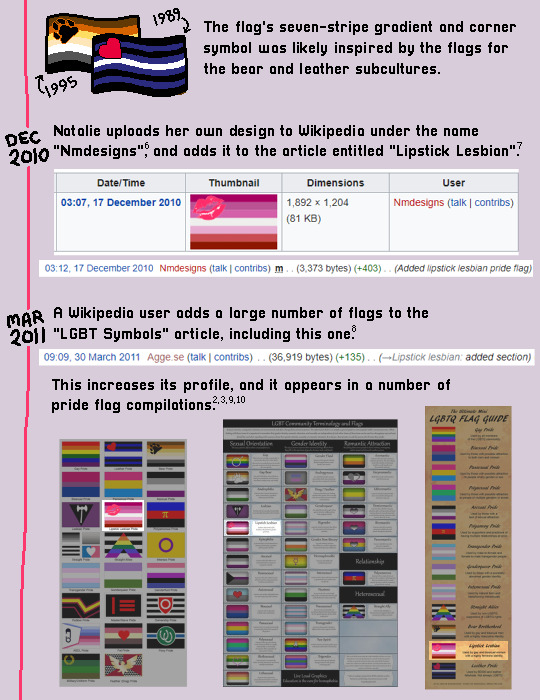
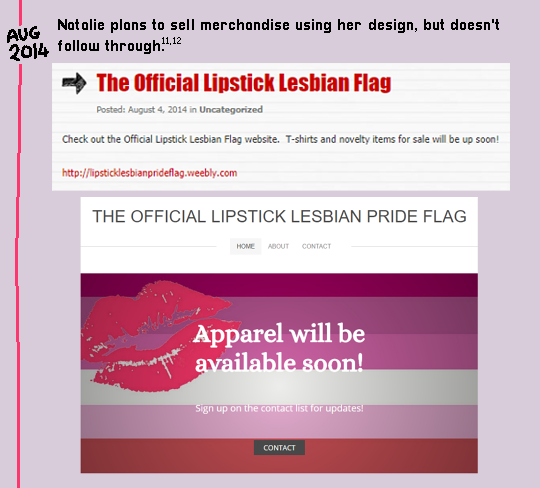
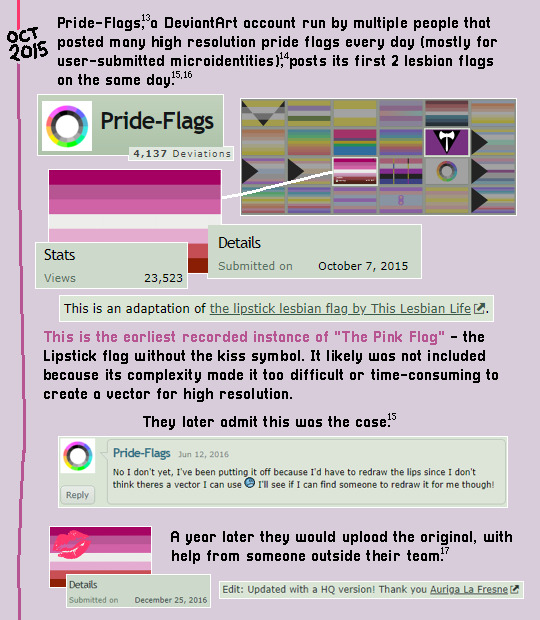
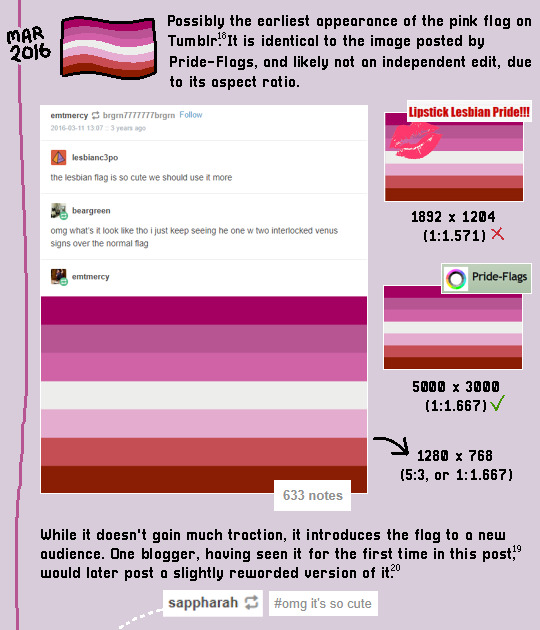

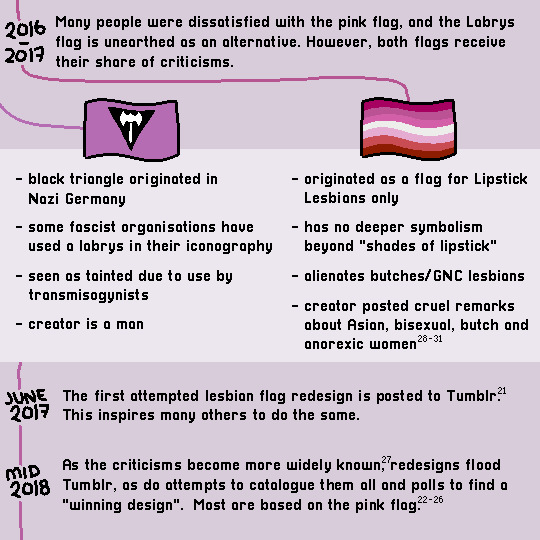

Seeing a lot of misinformation flying around regarding lesbian flags this year, particularly the pink one, so here’s my attempt to set the record straight!
FAQ/Common Misconceptions and Sources are listed below the cut - if anything in this post contradicts what you’ve heard, I’d encourage you to read through them before responding.
Please DO NOT promote flag redesigns on this post :)
Keep reading
67K notes
·
View notes
Text
Ironically enough, Rita Mae Brown, who is well known as the author of the 1973 lesbian novel Rubyfruit Jungle and was also a founding member of the lesbian separatist Furies Collective (during which time she expressed disapproval of bisexuality), apparently continued to have sexual relationships with men, and later called “lesbian” a “misnomer” for herself and claimed most people were “degrees of bisexual.”
Which just goes to show that even some of the influential women involved in shaping quintessential “lesbian culture,” including the parts of it that professed a rejection of bisexuality, could themselves have complicated sexual practices and self-understandings which didn’t totally preclude relationships with men.
From the dissertation “Love and Liberation: Second-Wave Feminisms and the Problem of Romantic Love” by Robin Kay-Marie Payne, 2010:
Whether Brown was truly the “only visible lesbian” is certainly debatable; however, the bigger contradiction that becomes most apparent in her memoir, her diaries, and her personal correspondence was that Brown was actually a practicing bisexual. During her tenure in the Radicalesbians and The Furies, Brown had counted herself among the coterie of political lesbians who saw bisexuality as a cop-out and once wrote: “You can’t have your cake and eat it too. You can’t be tied to male privilege with the right hand while clutching to your sister with the left.” She continued, “Lesbianism is the only road toward removing yourself from male ways and beginning to learn equality.”[135] Perhaps Brown’s views had softened or maybe she counted herself among the few evolved folks who could live the ideal, despite the persistence of male supremacy. Maybe she did not count her own dalliances with men as exercises in heterosexual privilege since she did not have long-term romantic relationships with them. Perhaps she decided she would also like to have her cake and eat it too. Regardless of theoretical justifications (or lack thereof), the fact remained that after the mid-1970s, Brown sometimes engaged in sexual relationships with men. She mentioned at least twice in her diary that she had the occasional affair with a “kind and bright woman or man,”[136] and on another occasion claimed to “belong to neither camp” of straight women or lesbians “nor the bisexuals.” “I find the entire process of categorization obscene,” she wrote.[137]
Keep reading
89 notes
·
View notes
Link
http://web.archive.org/web/20200809123749if_/https://www.washingtonpost.com/history/2019/11/16/like-chasing-shadows-uncovering-colonial-williamsburgs-lgbtq-history/
I found this article the other day and it made me super excited. Fun fact: this is where I’m going for my birthday next year, because what other place would a history nerd like myself want to turn 30 at?
61 notes
·
View notes
Text
I have researched this cultural phenomenon -- the blurred lines between lesbians and bisexual women -- for the past year. I included several sources below which discuss bisexual women and how they fit into past lesbian communities. Most of the sources focus on twentieth-century, American queer women. I hope this helps!
““The Famous Lady Lovers:” African American Women and Same-Sex Desire from Reconstruction to World War II”, Christina Anne Woolner (2014)
““Lady lovers” was also used in the black press interchangeably with “women lovers,” and as this term was indigenous to the urban North in the early-twentieth century, in black as well as white circles, I use it whenever possible. While many of the women in this dissertation had relationships with both men and women and were, as Russell noted, therefore “bisexual” in contemporary parlance, I rarely use this term since it was not utilized at the time. I refer to “lesbianism” throughout this study as the concept of women-loving-women and the act of building a life with a female partner while “lesbian” is generally referred to a trope in discourse.” (pp. 25-26)
https://deepblue.lib.umich.edu/bitstream/handle/2027.42/110469/cwoolner_1.pdf?sequence=1
-
“Historical Sources of the Bisexual Movement”; Queer Studies anthology, Amanda Udis-Kessler (1996)
https://books.google.com/books?id=tOATCgAAQBAJ&newbks=1&newbks_redir=0&lpg=PP1&dq=queer%20studies%20historical%20bisexual%20sources&pg=PA52#v=onepage&q&f=false
-
“Lesbian Health: Current Assessment and Directions for the Future”, (1999)
“There is no standard definition of lesbian. The term has been used to describe women who have sex with women, either exclusively or in addition to sex with men (i.e., behavior); women who self-identify as lesbian (i.e., identity); and women who sexual preference is for women (i.e., desire or attraction). The lack of a standard definition of lesbian and of standard questions to assess who is lesbian has made it difficult to clearly define a population of lesbian women. In the research literature, definitions of lesbian also vary depending on how and where study samples have been obtained.” (p. 22)
-
“Passions Between Women: British Lesbian Culture 1668–1801”, Emma Donoghue (1993)
“While many of make a useful erotic and political distinction between the labels ‘lesbian’ and ‘bisexual’ today, I have found little evidence of any such distinction in seventeenth- and eighteenth-century texts. Occasionally a writer remarks on the exclusivity of a woman’s devotion to her own sex (see pp. 82-3); even more rarely, a women’s sexual interest in men as well as in women is mentioned as unusual (p. 236). But usually what writers comment on is the quality of passion between two women, not their personal histories. Lesbian culture seems to have been understood as a matter of relationships and habitual practices rather than self-identifications. Whether or not a woman also had loving relationships with men, her passionate connections with women were worthy of comment.” (pp. 7-8)
-
Twitter thread (sourced)
https://taylorssources.tumblr.com/post/190644237922/authoratmidnight-smallswingshoes
-
“Gay Men, Lesbians, And Sex: Doing It Together”; Public Sex: The Culture of Radical Sex anthology, Pat Califia (1983) (1994)
“During one of our interminable discussions in Samois about whether or not to keep the group open to bi women, Gayle Rubin pointed out that a new, movement-oriented definition of lesbianism was in conflict with an older, bar-oriented definition. Membership in the old gay culture consisted of managing to locate a gay bar and making a place for yourself in bar society. Even today, nobody in a bar asks you how long you’ve been celibate with half the human race before they will check your coat and take your order for a drink.” (p. 195)
-
“Spreading depths: lesbian and bisexual women in English Canada, 1910-1965”, Karen Duder (2001)
(p. 3), (p. 167), (p. 184)
http://dspace.library.uvic.ca:8080/bitstream/handle/1828/3218/Duder_PhD_full.pdf?sequence=1
-
“Bisexual Movement”; Encyclopedias of Lesbian Histories and Cultures anthology, Robyn Ochs, Liz Highleyman (2000) (pp. 112-114)
https://robynochs.com/bisexual-movement/
-
“LETTERS From CAMP Rehoboth — PAST Out: What is the history of the bisexual movement?”, Liz Highleyman (2003)
“"Gay" was originally interpreted as encompassing anyone who had same-sex relationships, exclusively or not. But tensions grew as the gayand later the gay and lesbianmovement adopted a more identity-based politics. Perceived as being "on the fence," bisexuals were pressured to choose sides and embrace a gay or lesbian identityor else were told that they didn't exist. “For all the credibility I get, I might as well be calling myself a centaur or a mermaid,” wrote Louise Knox in a 1974 article.”
https://www.camprehoboth.com/letters/2003/july-11-2003-past-out
-
“Bisexual Characters in Film: From Anaïs to Zee”, Wayne M. Bryant (2009)
https://books.google.com/books?id=eaS0AQAAQBAJ&lpg=PP1&pg=PA135#v=onepage&q&f=false (pp. 135-136)
I really want to make a post addressing that whole notion that there used to be zero distinction between lesbians and bi women until [lesbian feminism] and then suddenly there was an absolute, universal (and, depending on whom you ask, never-again-to-be-questioned) distinction between them, but I’m in Must Collect More Data mode about it.
16 notes
·
View notes